See Page 1 |
2 |
3 |
4 of the September 2022 homepage archives. Wednesday the 7th
 If you like pronouncing long, complex chemical
names, you'll really enjoy this "Plastic
Film Capacitors" article from a 1967 issue of Electronics World magazine.
It was written by Walter Lamphier of Sprague Electric, a long-time manufacturer
of capacitors of all sorts. As of 1992, Vishay has owned Sprague (founded in 1926
by Robert Sprague), but has strategically retained the very familiar Sprague name
as part of theirs. Anyway, a lot of information is provided about the relatively
new (at the time) plastic-film construction. A contemporary article on the same
subject would no doubt include a whole host of new chemical compounds not even invented
in 1967. This particular issue of Electronics World reports on a few other
kinds of capacitor constructions popular at the time, including paper, ceramic,
glass, and electrolytic... If you like pronouncing long, complex chemical
names, you'll really enjoy this "Plastic
Film Capacitors" article from a 1967 issue of Electronics World magazine.
It was written by Walter Lamphier of Sprague Electric, a long-time manufacturer
of capacitors of all sorts. As of 1992, Vishay has owned Sprague (founded in 1926
by Robert Sprague), but has strategically retained the very familiar Sprague name
as part of theirs. Anyway, a lot of information is provided about the relatively
new (at the time) plastic-film construction. A contemporary article on the same
subject would no doubt include a whole host of new chemical compounds not even invented
in 1967. This particular issue of Electronics World reports on a few other
kinds of capacitor constructions popular at the time, including paper, ceramic,
glass, and electrolytic...
 "Researchers have developed a new
chip-based beam steering technology that provides a promising route to small,
cost-effective, and high-performance lidar systems. Lidar, or light detection and
ranging, uses laser pulses to acquire 3D information about a scene or object. It
is used in a wide range of applications such as autonomous driving, 3D holography,
biomedical sensing, free-space optical communications, and virtual reality. 'Optical
beam steering is a key technology for lidar systems, but conventional mechanical-based
beam steering systems are bulky, expensive, sensitive to vibration, and limited
in speed,' said research team leader Hao Hu from the Technical University of Denmark.
'Although devices known as chip-based optical phased arrays (OPAs) can quickly and
precisely steer light in a non-mechanical way, so far, these devices have had poor
beam quality and a field of view typically below 100°..." "Researchers have developed a new
chip-based beam steering technology that provides a promising route to small,
cost-effective, and high-performance lidar systems. Lidar, or light detection and
ranging, uses laser pulses to acquire 3D information about a scene or object. It
is used in a wide range of applications such as autonomous driving, 3D holography,
biomedical sensing, free-space optical communications, and virtual reality. 'Optical
beam steering is a key technology for lidar systems, but conventional mechanical-based
beam steering systems are bulky, expensive, sensitive to vibration, and limited
in speed,' said research team leader Hao Hu from the Technical University of Denmark.
'Although devices known as chip-based optical phased arrays (OPAs) can quickly and
precisely steer light in a non-mechanical way, so far, these devices have had poor
beam quality and a field of view typically below 100°..."
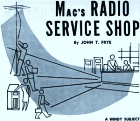 It is a pretty good bet that most multi-element
TV aerials you find on rooftops and even on ancient towers were decommissioned years
ago. They have been replaced either with cable (whether via CATV or Internet) or
satellite dishes. A few hold-outs still use them for local over-the-air broadcast
stations and/or even FM radio reception. There was a time, though, that photographs
taken looking across a vast expanse of house roofs showing an endless array of antennas
and guy wires was a sign of "modern" living. Most were erected by Harry Homeowner
types or minimally qualified service technicians, and were well-known for toppling,
twisting, bending or un-aligning when stiff winds were imposed upon them. This story-lesson
from the March 1953 edition "Mac's
Radio Service Shop," a regular feature in Radio & Television News magazine,
provides a bit of analysis on causes of failure due to improper guying and why many
people's "One Hoss Shay" of an installation failed despite their best efforts... It is a pretty good bet that most multi-element
TV aerials you find on rooftops and even on ancient towers were decommissioned years
ago. They have been replaced either with cable (whether via CATV or Internet) or
satellite dishes. A few hold-outs still use them for local over-the-air broadcast
stations and/or even FM radio reception. There was a time, though, that photographs
taken looking across a vast expanse of house roofs showing an endless array of antennas
and guy wires was a sign of "modern" living. Most were erected by Harry Homeowner
types or minimally qualified service technicians, and were well-known for toppling,
twisting, bending or un-aligning when stiff winds were imposed upon them. This story-lesson
from the March 1953 edition "Mac's
Radio Service Shop," a regular feature in Radio & Television News magazine,
provides a bit of analysis on causes of failure due to improper guying and why many
people's "One Hoss Shay" of an installation failed despite their best efforts...
 This new state of the art
Model 8060 Impedance Tuner / Generator from Berkeley Nucleonics puts reliable,
repeatable noise parameter measurements in your lab at about $10k, an order of magnitude
below what a mechanical table top system might cost. The compact digital device
offers a standard frequency range from 0.1 MHz to 6.0 GHz and can be customized
to tuned up or down for application-specific needs. A cryogenic option (Model 8060C)
provides greater performance capability allowing cold noise parameter measurements.
The small size and fully electronic design permit noise-parameter measurements of
packaged and on-wafer devices, ensuring flexibility and short test times. The Model
8060C is designed to work down to absolute zero temperature (Zero Kelvin) use primarily
in Radio Astronomy and Space Exploration, cryogenic Nuclear Magnetic Resonance (NMR),
and Quantum Computers. A host of MATLAB and other scripts are provided to allow
users to take advantage of their own VNA, Spectrum Analyzer, and Noise Source... This new state of the art
Model 8060 Impedance Tuner / Generator from Berkeley Nucleonics puts reliable,
repeatable noise parameter measurements in your lab at about $10k, an order of magnitude
below what a mechanical table top system might cost. The compact digital device
offers a standard frequency range from 0.1 MHz to 6.0 GHz and can be customized
to tuned up or down for application-specific needs. A cryogenic option (Model 8060C)
provides greater performance capability allowing cold noise parameter measurements.
The small size and fully electronic design permit noise-parameter measurements of
packaged and on-wafer devices, ensuring flexibility and short test times. The Model
8060C is designed to work down to absolute zero temperature (Zero Kelvin) use primarily
in Radio Astronomy and Space Exploration, cryogenic Nuclear Magnetic Resonance (NMR),
and Quantum Computers. A host of MATLAB and other scripts are provided to allow
users to take advantage of their own VNA, Spectrum Analyzer, and Noise Source...
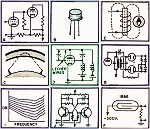 Robert P. Balin created many electronics-related
quizzes for Popular Electronics magazine. I have posted lots of them here
on RF Cafe, and will post more in the future. He designed quizzes for Electronics
World magazine before the publication's name changed to Popular Electronics.
Most of the Popular Electronics era quizzes were pretty easy for anyone
who has been in the electronics realm a few years. However, this "Co-Inventors
Quiz" from a 1965 issue of Electronics World is a real head scratcher.
I was only able to get two out of 10 answers correct. It would take someone who
is a physics historian to even come close to acing it - that or I'm really just
lacking in historical knowledge. Bon chance. Robert P. Balin created many electronics-related
quizzes for Popular Electronics magazine. I have posted lots of them here
on RF Cafe, and will post more in the future. He designed quizzes for Electronics
World magazine before the publication's name changed to Popular Electronics.
Most of the Popular Electronics era quizzes were pretty easy for anyone
who has been in the electronics realm a few years. However, this "Co-Inventors
Quiz" from a 1965 issue of Electronics World is a real head scratcher.
I was only able to get two out of 10 answers correct. It would take someone who
is a physics historian to even come close to acing it - that or I'm really just
lacking in historical knowledge. Bon chance.
 RF Cafe's raison d'être is and
always has been to provide useful, quality content for engineers, technicians,
engineering managers, students, and hobbyists. Part of that mission is offering
to post applicable job openings. HR department employees and/or managers of
hiring companies are welcome to submit opportunities for posting at no charge
(of course a gratuity will be graciously accepted). 3rd party recruiters and
temp agencies are not included so as to assure a high quality of listings.
Please read through the easy procedure to benefit from RF Cafe's high quality
visitors ... RF Cafe's raison d'être is and
always has been to provide useful, quality content for engineers, technicians,
engineering managers, students, and hobbyists. Part of that mission is offering
to post applicable job openings. HR department employees and/or managers of
hiring companies are welcome to submit opportunities for posting at no charge
(of course a gratuity will be graciously accepted). 3rd party recruiters and
temp agencies are not included so as to assure a high quality of listings.
Please read through the easy procedure to benefit from RF Cafe's high quality
visitors ...
 Berkeley Nucleonics Corporation (BNC) is
a leading manufacturer of precision electronic instrumentation for test, measurement,
and nuclear research. Founded in 1963, BNC initially developed custom pulse generators.
We became known for meeting the most stringent requirements for high precision and
stability, and for producing instruments of unsurpassed reliability and performance.
We continue to maintain a leadership position as a developer of custom pulse, signal,
light, and function generators. Our designs incorporate the latest innovations in
software and hardware engineering, surface mount production, and automated testing
procedures. Berkeley Nucleonics Corporation (BNC) is
a leading manufacturer of precision electronic instrumentation for test, measurement,
and nuclear research. Founded in 1963, BNC initially developed custom pulse generators.
We became known for meeting the most stringent requirements for high precision and
stability, and for producing instruments of unsurpassed reliability and performance.
We continue to maintain a leadership position as a developer of custom pulse, signal,
light, and function generators. Our designs incorporate the latest innovations in
software and hardware engineering, surface mount production, and automated testing
procedures.
Tuesday the 6th
 If anything qualifies for meeting the criteria
of the old adage that says "Necessity is the mother of invention," it is
coaxial
transmission cable. Wireless communications during World War II was the
necessity that drove the rapid development and continuous improvement of coax. Other
than materials technology for wire, dielectric, protective jacket, etc., the basics
of coax cable have not changed since this article appeared in a 1946 issue of
QST magazine. It was during the war that polyethylene was developed and
adopted as a dielectric material much superior to previously used copolene. Understanding
of how electromagnetic fields propagate within and, under non-ideal conditions -
on the outside of the cable has increased significantly thanks for refined theory
and high speed computer simulations. RG-58 were early 50 Ω coax types, and
RG-59, RG-11, and RG-6 were early 75 Ω coax types that are all still in significant
use today... If anything qualifies for meeting the criteria
of the old adage that says "Necessity is the mother of invention," it is
coaxial
transmission cable. Wireless communications during World War II was the
necessity that drove the rapid development and continuous improvement of coax. Other
than materials technology for wire, dielectric, protective jacket, etc., the basics
of coax cable have not changed since this article appeared in a 1946 issue of
QST magazine. It was during the war that polyethylene was developed and
adopted as a dielectric material much superior to previously used copolene. Understanding
of how electromagnetic fields propagate within and, under non-ideal conditions -
on the outside of the cable has increased significantly thanks for refined theory
and high speed computer simulations. RG-58 were early 50 Ω coax types, and
RG-59, RG-11, and RG-6 were early 75 Ω coax types that are all still in significant
use today...
 Empower RF Systems Model 2237 is a high
performance,
liquid cooled, pulsed transmitter operating from 1 to 2 GHz, designed for maximum
waveform flexibility. Another variation of Empower's Gen3 platform, the 2237 is
configured for L-Band radar, test, and EW applications. The deployment of the 2237,
along with the previously announced 2244, further solidifies the solid state, high
power, liquid cooled L-Band product baseline that has been developed. This new modern
architecture offers scalability for affordable upgrade paths to future power needs
by adding hardware to an existing system. The 2237 transmitter layout consists of
a system controller in a 3U 19-inch rack unit and 16 hot swappable 2U amplifier
drawers with each amplifier drawer containing an integrated power supply in its
2U chassis. There is no separate system level power supply... Empower RF Systems Model 2237 is a high
performance,
liquid cooled, pulsed transmitter operating from 1 to 2 GHz, designed for maximum
waveform flexibility. Another variation of Empower's Gen3 platform, the 2237 is
configured for L-Band radar, test, and EW applications. The deployment of the 2237,
along with the previously announced 2244, further solidifies the solid state, high
power, liquid cooled L-Band product baseline that has been developed. This new modern
architecture offers scalability for affordable upgrade paths to future power needs
by adding hardware to an existing system. The 2237 transmitter layout consists of
a system controller in a 3U 19-inch rack unit and 16 hot swappable 2U amplifier
drawers with each amplifier drawer containing an integrated power supply in its
2U chassis. There is no separate system level power supply...
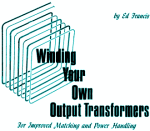 Even if you no longer - or never did - have
the need to wind your own
audio frequency output impedance matching transformers, this article from a
1970 issue of Popular Electronics magazine provides good insight into the factors
necessary for consideration when doing so. One particularly nice feature here is
that power handling is taken into account, including wire size to use for the primary
and secondary (or multiple outputs). At audio frequencies, where the transformer
is driving speakers with typical impedances of 4, 8, or 16 ohms, you do not need
to worry too much about parasitic capacitance and inductance. The basic equations
do a pretty good job of predicting performance. Author Ed Francis explains how to
modify a junk-box laminated core transformer to work, as well as providing a table
of enameled wire size ampacities and turns per linear inch. An example of how to
perform all the steps is given... Even if you no longer - or never did - have
the need to wind your own
audio frequency output impedance matching transformers, this article from a
1970 issue of Popular Electronics magazine provides good insight into the factors
necessary for consideration when doing so. One particularly nice feature here is
that power handling is taken into account, including wire size to use for the primary
and secondary (or multiple outputs). At audio frequencies, where the transformer
is driving speakers with typical impedances of 4, 8, or 16 ohms, you do not need
to worry too much about parasitic capacitance and inductance. The basic equations
do a pretty good job of predicting performance. Author Ed Francis explains how to
modify a junk-box laminated core transformer to work, as well as providing a table
of enameled wire size ampacities and turns per linear inch. An example of how to
perform all the steps is given...
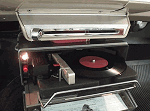 Before magnetic cassette and 8-track tape
decks, then compact disks (CD's) and digital video disks (DVD's, although now called
digital versatile disks) provided for personalized music selections while on the
road, Chrysler featured an in-dash record player dubbed "Highway
Hi-Fi." Just as the old Walkman
type players suffered from skips due to shocks, the automobile-based record player
had similar issues, only more severe. In fact, the Highway Hi-Fi player needed a
high pressure tone arm that subjected a lot of wear on record grooves. Because of
that, special heavy-duty records were pressed by Columbia Records in an LP format
that crammed a full hour of content on each side of the album. Accordingly, the
selection of artists and songs was limited. Ultimately, the cost, complexity, and
poor performance resulted in a failed idea. As the old saying goes, it's the pioneers
who catch the arrows. Before magnetic cassette and 8-track tape
decks, then compact disks (CD's) and digital video disks (DVD's, although now called
digital versatile disks) provided for personalized music selections while on the
road, Chrysler featured an in-dash record player dubbed "Highway
Hi-Fi." Just as the old Walkman
type players suffered from skips due to shocks, the automobile-based record player
had similar issues, only more severe. In fact, the Highway Hi-Fi player needed a
high pressure tone arm that subjected a lot of wear on record grooves. Because of
that, special heavy-duty records were pressed by Columbia Records in an LP format
that crammed a full hour of content on each side of the album. Accordingly, the
selection of artists and songs was limited. Ultimately, the cost, complexity, and
poor performance resulted in a failed idea. As the old saying goes, it's the pioneers
who catch the arrows.
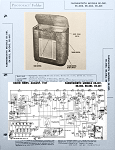 These schematics & parts lists for the
Farnsworth models EK-081, EK-082, EK-083, EK-681 radio were scanned from a 1947
issue of Radio News magazine. Most often a description of the radio's tuning
procedure would be included a la an abbreviated version of the Sams Photofacts data,
but sometimes only bare bones information was provided. Still, service shops and
hobbyists appreciated having it made available because manufacturers usually only
provided service information to authorized dealers. In the days of Internet, locating
such things could prove nearly impossible. There are still many people who restore
and service these vintage radios, and often it can be difficult or impossible to
find schematics and/or tuning information. I keep a running list of all data sheets
to facilitate a search... These schematics & parts lists for the
Farnsworth models EK-081, EK-082, EK-083, EK-681 radio were scanned from a 1947
issue of Radio News magazine. Most often a description of the radio's tuning
procedure would be included a la an abbreviated version of the Sams Photofacts data,
but sometimes only bare bones information was provided. Still, service shops and
hobbyists appreciated having it made available because manufacturers usually only
provided service information to authorized dealers. In the days of Internet, locating
such things could prove nearly impossible. There are still many people who restore
and service these vintage radios, and often it can be difficult or impossible to
find schematics and/or tuning information. I keep a running list of all data sheets
to facilitate a search...
 With more than 1000
custom-built symbols, this has got to be the most comprehensive set of
Visio Symbols available for RF, analog, and digital system and schematic
drawings! Every object has been built to fit proportionally on the provided
A-, B- and C-size drawing page templates (or can use your own). Symbols are provided
for equipment racks and test equipment, system block diagrams, conceptual drawings,
and schematics. Unlike previous versions, these are NOT Stencils, but instead are
all contained on tabbed pages within a single Visio document. That puts everything
in front of you in its full glory. Just copy and paste what you need on your drawing.
The file format is XML so everything plays nicely with Visio 2013 and later... With more than 1000
custom-built symbols, this has got to be the most comprehensive set of
Visio Symbols available for RF, analog, and digital system and schematic
drawings! Every object has been built to fit proportionally on the provided
A-, B- and C-size drawing page templates (or can use your own). Symbols are provided
for equipment racks and test equipment, system block diagrams, conceptual drawings,
and schematics. Unlike previous versions, these are NOT Stencils, but instead are
all contained on tabbed pages within a single Visio document. That puts everything
in front of you in its full glory. Just copy and paste what you need on your drawing.
The file format is XML so everything plays nicely with Visio 2013 and later...
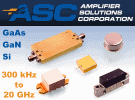 ASC designs and manufactures hybrid, surface
mount flange, open carrier and connectorized amplifiers for low, medium and high
power applications using gallium nitride (GaN), gallium arsenide (GaAs) and silicon
(Si) transistor technologies. ASC's thick film designs operate in the frequency
range of 300 kHz to 6 GHz. ASC offers thin film designs that operate up
to 20 GHz. ASC designs and manufactures hybrid, surface
mount flange, open carrier and connectorized amplifiers for low, medium and high
power applications using gallium nitride (GaN), gallium arsenide (GaAs) and silicon
(Si) transistor technologies. ASC's thick film designs operate in the frequency
range of 300 kHz to 6 GHz. ASC offers thin film designs that operate up
to 20 GHz.
Monday the 5th
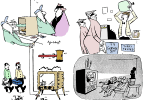 Mondays usually need help to keep spirits
up. Even though this is a three-day holiday weekend (Labor Day) weekend in the U.S.,
it is just another Monday in the rest of the world. Accordingly, here are a handful
of
electronics-themed comics from a 1959 issue of Radio-Electronics magazine.
You need to keep in mind the relative newness of televisions at the time, with the
reverence toward - and frustration with - the technology. Lots of artists had fun
poking fun at TV's and those who watched and serviced them. If you are in the U.S.
and don't see this until after returning to work, have a happy Tuesday. BTW, there
is a huge list of technology-themed comics at the bottom of the page - I've been
posting them for a couple decades now... Mondays usually need help to keep spirits
up. Even though this is a three-day holiday weekend (Labor Day) weekend in the U.S.,
it is just another Monday in the rest of the world. Accordingly, here are a handful
of
electronics-themed comics from a 1959 issue of Radio-Electronics magazine.
You need to keep in mind the relative newness of televisions at the time, with the
reverence toward - and frustration with - the technology. Lots of artists had fun
poking fun at TV's and those who watched and serviced them. If you are in the U.S.
and don't see this until after returning to work, have a happy Tuesday. BTW, there
is a huge list of technology-themed comics at the bottom of the page - I've been
posting them for a couple decades now...
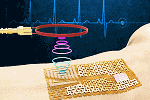 "A team led by Massachusetts Institute of
Technology (MIT) has devised an
electronic skin that communicates wirelessly without requiring chips or batteries.
Wearable sensors are ubiquitous thanks to wireless technology that enables a person's
glucose concentrations, blood pressure, heart rate and activity levels to be transmitted
seamlessly from sensor to smartphone for further analysis. Most wireless sensors
communicate via embedded Bluetooth chips that are powered by small batteries, but
these conventional chips and power sources may be too bulky for smaller, thinner
and more flexible next-generation sensors. The team's new sensor design, detailed
in Science, is a flexible 'e-skin' - a semiconducting film that conforms to the
skin like electronic Scotch tape..." "A team led by Massachusetts Institute of
Technology (MIT) has devised an
electronic skin that communicates wirelessly without requiring chips or batteries.
Wearable sensors are ubiquitous thanks to wireless technology that enables a person's
glucose concentrations, blood pressure, heart rate and activity levels to be transmitted
seamlessly from sensor to smartphone for further analysis. Most wireless sensors
communicate via embedded Bluetooth chips that are powered by small batteries, but
these conventional chips and power sources may be too bulky for smaller, thinner
and more flexible next-generation sensors. The team's new sensor design, detailed
in Science, is a flexible 'e-skin' - a semiconducting film that conforms to the
skin like electronic Scotch tape..."
 According to Radio-Craft magazine
founder and editor Hugo Gernsback, during the Roaring Twenties era in the U.S. -
and around much of the world for that matter - interest in the burgeoning field
of radio communications led to as many as half a million new entrants into the field
each year. As the novelty of the still-mystical wireless craft wore off and/or enthusiasts
discovered the technical aspects were too challenging, the numbers ebbed to a quarter
of the peak. The Stock Market crash in the Fall of 1929 didn't help matters, either.
By 1933, Gernsback was writing, "The
radio beginner these days is in a paradise of his own; he has low-priced merchandise,
he has an avalanche of new radio circuits, and radio tubes of every class and variety..." According to Radio-Craft magazine
founder and editor Hugo Gernsback, during the Roaring Twenties era in the U.S. -
and around much of the world for that matter - interest in the burgeoning field
of radio communications led to as many as half a million new entrants into the field
each year. As the novelty of the still-mystical wireless craft wore off and/or enthusiasts
discovered the technical aspects were too challenging, the numbers ebbed to a quarter
of the peak. The Stock Market crash in the Fall of 1929 didn't help matters, either.
By 1933, Gernsback was writing, "The
radio beginner these days is in a paradise of his own; he has low-priced merchandise,
he has an avalanche of new radio circuits, and radio tubes of every class and variety..."
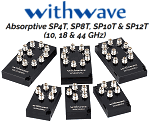 Withwave's
RF Switch Modules have absorptive RF switches such as SP4T, SP8T, SP10T &
SP12T according to switching applications and frequency range up to 44 GHz.
They delivers high isolation, low insertion loss and fast switching time, making
this devices ideal for RF signal routing in wireless infrastructure and applications
up to maximum frequency range. External Connectors included 2.92 mm vertical launch
connectors for all RF port. They are powered and controlled through USB 3.0 connector... Withwave's
RF Switch Modules have absorptive RF switches such as SP4T, SP8T, SP10T &
SP12T according to switching applications and frequency range up to 44 GHz.
They delivers high isolation, low insertion loss and fast switching time, making
this devices ideal for RF signal routing in wireless infrastructure and applications
up to maximum frequency range. External Connectors included 2.92 mm vertical launch
connectors for all RF port. They are powered and controlled through USB 3.0 connector...
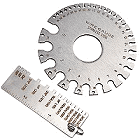 In 1931, QST reader John H. Miller,
Electrical Engineer, of the Jewell Electrical Instrument Company, wrote to the editor
regarding the story "What Is This Thing Called
Decibel?," by James L McLaughlin and James J. Lamb, which appeared in the August
issue of that year. Mr. Miller wished to inform (or remind) readers that the American
Wire Gauge system for assigning sizes to wire cross-section ratios closely follows
a decibel (i.e., logarithmic) relationship. Applying his information: A 28 AWG solid
wire has a cross-section of 160 circular mils, so at 3 sizes larger, 25 AWG should
be 320 circular mils. In fact, it is 320 circular mils (see table on the Copper
Wire Properties & Gauge Conversions page). A 12 AWG solid wire has a cross-section
of 5,630 circular mils, so at 3 sizes larger, 9 AWG should be 13,060 circular mils,
and it is 13,090 circular mils. That verifies the 3 dB per three differences
in gauge for two cases using small and large wire sizes. What about, say, 5 dB
for 5 wires sizes in difference? Using 28 AWG again as a reference, a 5 dB
increase in size for 28-5=23 AWG wire... In 1931, QST reader John H. Miller,
Electrical Engineer, of the Jewell Electrical Instrument Company, wrote to the editor
regarding the story "What Is This Thing Called
Decibel?," by James L McLaughlin and James J. Lamb, which appeared in the August
issue of that year. Mr. Miller wished to inform (or remind) readers that the American
Wire Gauge system for assigning sizes to wire cross-section ratios closely follows
a decibel (i.e., logarithmic) relationship. Applying his information: A 28 AWG solid
wire has a cross-section of 160 circular mils, so at 3 sizes larger, 25 AWG should
be 320 circular mils. In fact, it is 320 circular mils (see table on the Copper
Wire Properties & Gauge Conversions page). A 12 AWG solid wire has a cross-section
of 5,630 circular mils, so at 3 sizes larger, 9 AWG should be 13,060 circular mils,
and it is 13,090 circular mils. That verifies the 3 dB per three differences
in gauge for two cases using small and large wire sizes. What about, say, 5 dB
for 5 wires sizes in difference? Using 28 AWG again as a reference, a 5 dB
increase in size for 28-5=23 AWG wire...
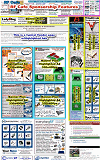 New Scheme rotates
all Banners in all locations on the page! RF Cafe typically receives 8,000-15,000
website visits each weekday.
RF Cafe is a favorite
of engineers, technicians, hobbyists, and students all over the world. With more
than 12,000 pages in the Google search index, RF Cafe returns in favorable
positions on many types of key searches, both for text and images. New content is
added on a daily basis, which keeps the major search engines interested enough to
spider it multiple times each day. Items added on the homepage often can be found
in a Google search within a few hours of being posted. I also re-broadcast homepage
items on LinkedIn. If you need your company news to be seen, RF Cafe is the
place to be. New Scheme rotates
all Banners in all locations on the page! RF Cafe typically receives 8,000-15,000
website visits each weekday.
RF Cafe is a favorite
of engineers, technicians, hobbyists, and students all over the world. With more
than 12,000 pages in the Google search index, RF Cafe returns in favorable
positions on many types of key searches, both for text and images. New content is
added on a daily basis, which keeps the major search engines interested enough to
spider it multiple times each day. Items added on the homepage often can be found
in a Google search within a few hours of being posted. I also re-broadcast homepage
items on LinkedIn. If you need your company news to be seen, RF Cafe is the
place to be.
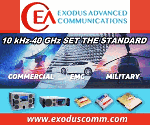 Exodus Advanced Communications is a multinational
RF communication equipment and engineering service company serving both commercial
and government entities and their affiliates worldwide. Power amplifiers ranging
from 10 kHz to 51 GHz with various output power levels and noise figure
ranges, we fully support custom designs and manufacturing requirements for both
small and large volume levels. decades of combined experience in the RF field for
numerous applications including military jamming, communications, radar, EMI/EMC
and various commercial projects with all designing and manufacturing of our HPA,
MPA, and LNA products in-house. Exodus Advanced Communications is a multinational
RF communication equipment and engineering service company serving both commercial
and government entities and their affiliates worldwide. Power amplifiers ranging
from 10 kHz to 51 GHz with various output power levels and noise figure
ranges, we fully support custom designs and manufacturing requirements for both
small and large volume levels. decades of combined experience in the RF field for
numerous applications including military jamming, communications, radar, EMI/EMC
and various commercial projects with all designing and manufacturing of our HPA,
MPA, and LNA products in-house.
Sunday the 4th
 This week's crossword puzzle for September
4th sports an
electrical engineering theme. All RF Cafe crossword puzzles are custom made
by me, Kirt Blattenberger, and have only words and clues related to RF, microwave,
and mm-wave engineering, optics, mathematics, chemistry, physics, and other technical
subjects. As always, this crossword contains no names of politicians, mountain ranges,
exotic foods or plants, movie stars, or anything of the sort unless it/he/she is
related to this puzzle's technology theme (e.g., Reginald Denny or the Tunguska
event in Siberia). The technically inclined cruciverbalists amongst us will appreciate
the effort. Enjoy! This week's crossword puzzle for September
4th sports an
electrical engineering theme. All RF Cafe crossword puzzles are custom made
by me, Kirt Blattenberger, and have only words and clues related to RF, microwave,
and mm-wave engineering, optics, mathematics, chemistry, physics, and other technical
subjects. As always, this crossword contains no names of politicians, mountain ranges,
exotic foods or plants, movie stars, or anything of the sort unless it/he/she is
related to this puzzle's technology theme (e.g., Reginald Denny or the Tunguska
event in Siberia). The technically inclined cruciverbalists amongst us will appreciate
the effort. Enjoy!
 Withwave manufactures an extensive line of
metrology quality coaxial test cable assemblies, connectors (wave-, end-, vertical-launch,
board edge, panel mount), calibration kits (SOLT), a
fully automated
4-port vector network analyzer (VNA) calibrator, between- and in-series connector
adaptors, attenuators, terminations, DC blocks, torque wrenches, test probes &
probe positioner. Special test fixtures for calibration and multicoax cable assemblies.
Frequency ranges from DC through 110 GHz. Please contact Withwave today to
see how they can help your project succeed. Withwave manufactures an extensive line of
metrology quality coaxial test cable assemblies, connectors (wave-, end-, vertical-launch,
board edge, panel mount), calibration kits (SOLT), a
fully automated
4-port vector network analyzer (VNA) calibrator, between- and in-series connector
adaptors, attenuators, terminations, DC blocks, torque wrenches, test probes &
probe positioner. Special test fixtures for calibration and multicoax cable assemblies.
Frequency ranges from DC through 110 GHz. Please contact Withwave today to
see how they can help your project succeed.
Friday the 2nd
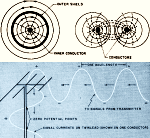 The debate regarding the superiority of
coaxial cable and twin-lead cable, aside from personal preferences, comes down
to this: Twin-lead cable has lower loss but is vulnerable to extraneous signal pick-up
and is sensitive to nearby objects in the routing path from antenna to receiver;
it is also inexpensive. Coaxial cable has higher loss and is more expensive, but
is significantly less sensitive to the routing path and external signal interference.
In strong signal areas and/or for short runs, higher loss in coax is not an issue,
and its higher cost can usually be justified for the near immunity from interference
advantage. In areas where the signal at the antenna is weak and the path length
to the receiver is long, twin-lead, aside from its lower cost, helps yield a better
signal. The same pros and cons apply for the other direction with a signal going
from a transmitter to an antenna, but this 1965 Electronics World magazine article
is addressing television and radio reception... The debate regarding the superiority of
coaxial cable and twin-lead cable, aside from personal preferences, comes down
to this: Twin-lead cable has lower loss but is vulnerable to extraneous signal pick-up
and is sensitive to nearby objects in the routing path from antenna to receiver;
it is also inexpensive. Coaxial cable has higher loss and is more expensive, but
is significantly less sensitive to the routing path and external signal interference.
In strong signal areas and/or for short runs, higher loss in coax is not an issue,
and its higher cost can usually be justified for the near immunity from interference
advantage. In areas where the signal at the antenna is weak and the path length
to the receiver is long, twin-lead, aside from its lower cost, helps yield a better
signal. The same pros and cons apply for the other direction with a signal going
from a transmitter to an antenna, but this 1965 Electronics World magazine article
is addressing television and radio reception...
 ConductRF knows many times you want to just
buy your RF assemblies to plug in to your circular D38999 connector or your VITA67
module. We offer multiple solutions for both styles of
multi-port connector all available on short lead times based on
our on hand materials stock. D38999 integrates BMA, SMPM & SMPS connectors,
also other #8, #12 & #16 coax contact solutions. VITA67.1/2 uses SMPM solutions,
but the new VITA67.3 also offers SMPS and NanoRF to support your coax. These are
100% factory tested to exacting VSWR and loss standards because we know, Results
Count! ConductRF knows many times you want to just
buy your RF assemblies to plug in to your circular D38999 connector or your VITA67
module. We offer multiple solutions for both styles of
multi-port connector all available on short lead times based on
our on hand materials stock. D38999 integrates BMA, SMPM & SMPS connectors,
also other #8, #12 & #16 coax contact solutions. VITA67.1/2 uses SMPM solutions,
but the new VITA67.3 also offers SMPS and NanoRF to support your coax. These are
100% factory tested to exacting VSWR and loss standards because we know, Results
Count!
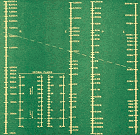 Maybe given the nature of the newly introduced
Popular Electronics magazine (this was only the third issue), the editors
decided using a big word like "nomograph"
might be a little too out of the realm for use in a magazine seeking to appeal to
newcomers to the electronics field. It is a little surprising since students of
the day were quite accustomed to using this type of a graph since computers still
filled entire rooms and hand-held calculators went by a different name - slide rules.
In fact, because of a familiarity with using a slide rule, people were more accustomed
to having to shift decimal points to the left or right first to do the calculation
on a device that only displayed values in a single decade range, and then to arrive
at the final answer after the calculation. That is exactly the skill needed to use
the nomograph. I guess that people today - even engineers - would have a harder
time keeping track of powers of 10 than... Maybe given the nature of the newly introduced
Popular Electronics magazine (this was only the third issue), the editors
decided using a big word like "nomograph"
might be a little too out of the realm for use in a magazine seeking to appeal to
newcomers to the electronics field. It is a little surprising since students of
the day were quite accustomed to using this type of a graph since computers still
filled entire rooms and hand-held calculators went by a different name - slide rules.
In fact, because of a familiarity with using a slide rule, people were more accustomed
to having to shift decimal points to the left or right first to do the calculation
on a device that only displayed values in a single decade range, and then to arrive
at the final answer after the calculation. That is exactly the skill needed to use
the nomograph. I guess that people today - even engineers - would have a harder
time keeping track of powers of 10 than...
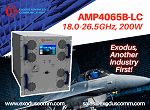 Exodus Advanced Communications is a multinational
RF communication equipment and engineering service company serving both commercial
and government entities and their affiliates worldwide. We are pleased to present
the new Exodus Model
AMP4065B-LC, 18.0-26.5 GHz, 200 W Solid State Amplifier - another
industry first from Exodus. Designed for High Field Level EMC Testing, Mil-Std 461(RS103)
standards as well as other High-Power Applications. Exodus Model AMP4065B-LC is
a 12U design providing outstanding power/gain flatness, Forward/Reflected power
monitoring in both dBm & Watts, VSWR, voltage/current and temperature sensing
for superb reliability and ruggedness. Unprecedented reliability compared to TWT's,
53 dB gain including gain control, and -20 dBc harmonics. 10 W, 20 W,
40 W, 60 W & 100 W versions available... Exodus Advanced Communications is a multinational
RF communication equipment and engineering service company serving both commercial
and government entities and their affiliates worldwide. We are pleased to present
the new Exodus Model
AMP4065B-LC, 18.0-26.5 GHz, 200 W Solid State Amplifier - another
industry first from Exodus. Designed for High Field Level EMC Testing, Mil-Std 461(RS103)
standards as well as other High-Power Applications. Exodus Model AMP4065B-LC is
a 12U design providing outstanding power/gain flatness, Forward/Reflected power
monitoring in both dBm & Watts, VSWR, voltage/current and temperature sensing
for superb reliability and ruggedness. Unprecedented reliability compared to TWT's,
53 dB gain including gain control, and -20 dBc harmonics. 10 W, 20 W,
40 W, 60 W & 100 W versions available...
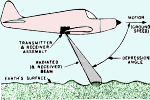 Doppler radar is familiar to most people
these days mainly because of the weather reports available online and on television
reports. Not many actually understand the principle behind it, though. A handful
can tell you that in sound form it is the frequency shift phenomenon that occurs
when a train goes by while blowing its horn. Almost none could say why or how it
is useful in detecting storm systems or for tracking aircraft. This 1959 Popular
Electronics magazine article attempts to explain Doppler radar to the uninitiated.
Having worked as an air traffic control radar technician in the USAF, and then having
done the RF and analog system circuit design for a prototype Doppler weather radar
as an engineer, I have had a lot of exposure, but I am by no means an expert... Doppler radar is familiar to most people
these days mainly because of the weather reports available online and on television
reports. Not many actually understand the principle behind it, though. A handful
can tell you that in sound form it is the frequency shift phenomenon that occurs
when a train goes by while blowing its horn. Almost none could say why or how it
is useful in detecting storm systems or for tracking aircraft. This 1959 Popular
Electronics magazine article attempts to explain Doppler radar to the uninitiated.
Having worked as an air traffic control radar technician in the USAF, and then having
done the RF and analog system circuit design for a prototype Doppler weather radar
as an engineer, I have had a lot of exposure, but I am by no means an expert...
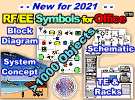 It was a lot of work, but I finally finished
a version of the "RF & Electronics Schematic & Block Diagram Symbols" that
works well with Microsoft Office™ programs Word™, Excel™, and Power Point™.
This is an equivalent of the extensive set of amplifier, mixer, filter, switch,
connector, waveguide, digital, analog, antenna, and other commonly used symbols
for system block diagrams and schematics created for Visio™. Each of the 1,000 or
so symbols was exported individually from Visio in the EMF file format, then imported
into Word on a Drawing Canvas. The EMF format allows an image to be scaled up or
down without becoming pixelated, so all the shapes can be resized in a document
and still look good. The imported symbols can also be UnGrouped into their original
constituent parts for editing. Check them out! It was a lot of work, but I finally finished
a version of the "RF & Electronics Schematic & Block Diagram Symbols" that
works well with Microsoft Office™ programs Word™, Excel™, and Power Point™.
This is an equivalent of the extensive set of amplifier, mixer, filter, switch,
connector, waveguide, digital, analog, antenna, and other commonly used symbols
for system block diagrams and schematics created for Visio™. Each of the 1,000 or
so symbols was exported individually from Visio in the EMF file format, then imported
into Word on a Drawing Canvas. The EMF format allows an image to be scaled up or
down without becoming pixelated, so all the shapes can be resized in a document
and still look good. The imported symbols can also be UnGrouped into their original
constituent parts for editing. Check them out!
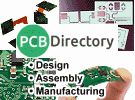 PCB Directory is the largest directory of
Printed Circuit
Board (PCB) Manufacturers, Assembly houses, and Design Services on the Internet.
We have listed the leading printed circuit board manufacturers around the world
and made them searchable by their capabilities - Number of laminates used, Board
thicknesses supported, Number of layers supported, Types of substrates (FR-4, Rogers,
flexible, rigid), Geographical location (U.S., China), kinds of services (manufacturing,
fabrication, assembly, prototype), and more. Fast turn-around on quotations for
PCB fabrication and assembly. PCB Directory is the largest directory of
Printed Circuit
Board (PCB) Manufacturers, Assembly houses, and Design Services on the Internet.
We have listed the leading printed circuit board manufacturers around the world
and made them searchable by their capabilities - Number of laminates used, Board
thicknesses supported, Number of layers supported, Types of substrates (FR-4, Rogers,
flexible, rigid), Geographical location (U.S., China), kinds of services (manufacturing,
fabrication, assembly, prototype), and more. Fast turn-around on quotations for
PCB fabrication and assembly.
Thursday the 1st
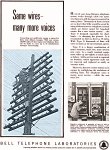 Always creating and pushing the leading
edge of communications technology, Bell Telephone Systems and their research group,
Bell Telephone Laboratories, frequently ran full-page promotions in many types of
magazines, from electronics industry publications like the 1952 issue of Radio-Electronics,
to domestic rags like Woman's Day and Better Homes and Gardens. In this instance,
Bell Labs was justifying its continued use of the original open-wire telephone line
distribution systems using poles with individual pairs rather than the newer multi-pair
cables that carried sometimes hundreds of circuits in the space of a few square
inches of cross-section, and in a protective sheath that guarded against signal
interference and weather degradation. An entire volume of the Bell System Technical
Journal (BSTJ) was published on the
Type-O (open wire) Carrier System in the same year this ad appeared. It basically
came down to economics based on the fact that so many thousands of miles of the
old lines in existence performed adequately well, and new technology allowed two
or more circuits to co-exist on the same twisted pair... Always creating and pushing the leading
edge of communications technology, Bell Telephone Systems and their research group,
Bell Telephone Laboratories, frequently ran full-page promotions in many types of
magazines, from electronics industry publications like the 1952 issue of Radio-Electronics,
to domestic rags like Woman's Day and Better Homes and Gardens. In this instance,
Bell Labs was justifying its continued use of the original open-wire telephone line
distribution systems using poles with individual pairs rather than the newer multi-pair
cables that carried sometimes hundreds of circuits in the space of a few square
inches of cross-section, and in a protective sheath that guarded against signal
interference and weather degradation. An entire volume of the Bell System Technical
Journal (BSTJ) was published on the
Type-O (open wire) Carrier System in the same year this ad appeared. It basically
came down to economics based on the fact that so many thousands of miles of the
old lines in existence performed adequately well, and new technology allowed two
or more circuits to co-exist on the same twisted pair...
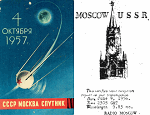 Securing confirmation of having made a contact
(QSL in ham-speak) with a radio operator behind the communist Iron Curtain was a
real achievement during most of the 20th century. Russian and Chinese citizens were
routinely imprisoned for such activity, and if you did manage to elicit a response
to your CQ (request for contact), there was a good chance it was with a government
propagandist posing as a civilian. When
Sputnik 1 was put in orbit on October 4, 1957, a whole new realm of DXing
(long distance communication) opened up by providing satellite relay paths. Sputnik 1,
the world's first artificial satellite, broadcast a series of pulses at 20.005 and
40.002 MHz that were tracked and reported by both professional and amateur
radio operators. Vital data was learned based on the time and strength of signals
that allowed scientists to ascertain the physics of upper atmosphere characteristics... Securing confirmation of having made a contact
(QSL in ham-speak) with a radio operator behind the communist Iron Curtain was a
real achievement during most of the 20th century. Russian and Chinese citizens were
routinely imprisoned for such activity, and if you did manage to elicit a response
to your CQ (request for contact), there was a good chance it was with a government
propagandist posing as a civilian. When
Sputnik 1 was put in orbit on October 4, 1957, a whole new realm of DXing
(long distance communication) opened up by providing satellite relay paths. Sputnik 1,
the world's first artificial satellite, broadcast a series of pulses at 20.005 and
40.002 MHz that were tracked and reported by both professional and amateur
radio operators. Vital data was learned based on the time and strength of signals
that allowed scientists to ascertain the physics of upper atmosphere characteristics...
 Skyworks Skyworks Solutions today announced
the launch of its new portfolio of
network synchronization solutions, which includes the Si551x and Si540x families
of NetSync™ clock integrated circuit devices and Skyworks' AccuTime™ IEEE 1588 software.
Each product family is engineered to meet the requirements of mobile operators and
equipment vendors for 5G fronthaul networks. Precise and accurate time synchronization
is critical to ultra-reliable network operation and is paving the way for future
enhancements, including Ultra-Reliable Low-Latency Communications (URLLC) and Coordinated
Multipoint Access (CoMP) that empower 5G to support autonomous vehicles, factory
automation, telemedicine and other emerging applications. "Skyworks' decades of
expertise and patented timing technology enable the company to offer best-in-class
performance, integration and reliability, featuring its ultra-low jitter DSPLL®
architecture with MultiSynth™ 'any-frequency' clock synthesis... Skyworks Skyworks Solutions today announced
the launch of its new portfolio of
network synchronization solutions, which includes the Si551x and Si540x families
of NetSync™ clock integrated circuit devices and Skyworks' AccuTime™ IEEE 1588 software.
Each product family is engineered to meet the requirements of mobile operators and
equipment vendors for 5G fronthaul networks. Precise and accurate time synchronization
is critical to ultra-reliable network operation and is paving the way for future
enhancements, including Ultra-Reliable Low-Latency Communications (URLLC) and Coordinated
Multipoint Access (CoMP) that empower 5G to support autonomous vehicles, factory
automation, telemedicine and other emerging applications. "Skyworks' decades of
expertise and patented timing technology enable the company to offer best-in-class
performance, integration and reliability, featuring its ultra-low jitter DSPLL®
architecture with MultiSynth™ 'any-frequency' clock synthesis...
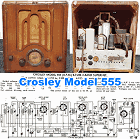 This is another Radio Service Data Sheet
that appeared in the March 1936 edition of Radio-Craft magazine. I post
this schematic and functional description of the
Crosley Model 555 (A.F.M.) 5-Tube 2-Band Superhet radio manufacturers' publications
for the benefit of hobbyists and archivists who might be searching for such information
either in a effort to restore a radio to working condition, or to collect archival
information. As mentioned previously, manufacturers usually did not provide this
data to anyone other than an authorized service shop, so making it available via
the magazine was a huge benefit to repair shops and do-it-yourselfers. Unfortunately,
not very much textual content was included with the schematic. It was part of a
group of seven different models (see table of contents), and not much more than
the schematic was provided for each... This is another Radio Service Data Sheet
that appeared in the March 1936 edition of Radio-Craft magazine. I post
this schematic and functional description of the
Crosley Model 555 (A.F.M.) 5-Tube 2-Band Superhet radio manufacturers' publications
for the benefit of hobbyists and archivists who might be searching for such information
either in a effort to restore a radio to working condition, or to collect archival
information. As mentioned previously, manufacturers usually did not provide this
data to anyone other than an authorized service shop, so making it available via
the magazine was a huge benefit to repair shops and do-it-yourselfers. Unfortunately,
not very much textual content was included with the schematic. It was part of a
group of seven different models (see table of contents), and not much more than
the schematic was provided for each...
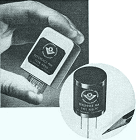 "Transistor Topics" was a monthly column
in Popular Electronics magazine that helped introduce and educate readers
to/on the relatively new topic of transistor design and troubleshooting. Transistors
were first invented in December of 1948, but it took about a decade before they
were reliable and inexpensive enough to be integrated into a large variety of products
- and affordable to the hobbyist. Editor Lou Garner often presented questions from
readers and answered in layman's terms. This month's question came from a reader
in Bogota, Columbia, which in 1960, was a big deal. Nowadays we take for granted
how small the world is due to the Internet. Aldens department store is mentioned,
which I remember moving into a shopping plaza next to Hechinger lumberyard and home
center in Annapolis, Maryland, sometime around 1970... "Transistor Topics" was a monthly column
in Popular Electronics magazine that helped introduce and educate readers
to/on the relatively new topic of transistor design and troubleshooting. Transistors
were first invented in December of 1948, but it took about a decade before they
were reliable and inexpensive enough to be integrated into a large variety of products
- and affordable to the hobbyist. Editor Lou Garner often presented questions from
readers and answered in layman's terms. This month's question came from a reader
in Bogota, Columbia, which in 1960, was a big deal. Nowadays we take for granted
how small the world is due to the Internet. Aldens department store is mentioned,
which I remember moving into a shopping plaza next to Hechinger lumberyard and home
center in Annapolis, Maryland, sometime around 1970...
 This assortment of custom-designed themes
by RF Cafe includes T-Shirts, Mouse Pads, Clocks, Tote Bags, Coffee Mugs and Steins,
Purses, Sweatshirts, and Baseball Caps. Choose from amazingly clever "We Are the World's
Matchmakers" Smith chart design or the "Engineer's Troubleshooting Flow Chart."
My "Matchmaker's" design has been ripped off by other people and used on their products,
so please be sure to purchase only official RF Cafe gear. My markup is only a paltry
50¢ per item - Cafe Press gets the rest of your purchase price. These would make
excellent gifts for husbands, wives, kids, significant others, and for handing out
at company events or as rewards for excellent service. It's a great way to help
support RF Cafe. Thanks... This assortment of custom-designed themes
by RF Cafe includes T-Shirts, Mouse Pads, Clocks, Tote Bags, Coffee Mugs and Steins,
Purses, Sweatshirts, and Baseball Caps. Choose from amazingly clever "We Are the World's
Matchmakers" Smith chart design or the "Engineer's Troubleshooting Flow Chart."
My "Matchmaker's" design has been ripped off by other people and used on their products,
so please be sure to purchase only official RF Cafe gear. My markup is only a paltry
50¢ per item - Cafe Press gets the rest of your purchase price. These would make
excellent gifts for husbands, wives, kids, significant others, and for handing out
at company events or as rewards for excellent service. It's a great way to help
support RF Cafe. Thanks...
 Empower RF Systems is a global leader in
power amplifier solutions. Empower RF Systems is an established and technologically
superior supplier of high power solid state RF & microwave amplifiers. Our offerings
include modules, intelligent rack-mount amplifiers, and multi-function RF Power
Amplifier solutions to 6 GHz in broadband and band specific designs. Output
power combinations range from tens of watts to multi-kilowatts. Unprecedented size,
weight and power reduction of our amplifiers is superior to anything in the market
at similar frequencies and power levels. Empower RF Systems is a global leader in
power amplifier solutions. Empower RF Systems is an established and technologically
superior supplier of high power solid state RF & microwave amplifiers. Our offerings
include modules, intelligent rack-mount amplifiers, and multi-function RF Power
Amplifier solutions to 6 GHz in broadband and band specific designs. Output
power combinations range from tens of watts to multi-kilowatts. Unprecedented size,
weight and power reduction of our amplifiers is superior to anything in the market
at similar frequencies and power levels.
These archive pages are provided in order to make it easier for you to find items
that you remember seeing on the RF Cafe homepage. Of course probably the easiest
way to find anything on the website is to use the "Search
RF Cafe" box at the top of every page.
About RF Cafe.
Homepage Archive Pages
2024:
Jan |
Feb |
Mar |
Apr |
May |
Jun |
Jul |
Aug |
Sep |
Oct |
Nov |
Dec
2023:
Jan |
Feb |
Mar |
Apr |
May |
Jun |
Jul |
Aug |
Sep |
Oct |
Nov |
Dec
2022:
Jan |
Feb |
Mar |
Apr |
May |
Jun |
Jul |
Aug |
Sep |
Oct |
Nov |
Dec
2021:
Jan |
Feb |
Mar |
Apr |
May |
Jun |
Jul |
Aug |
Sep |
Oct |
Nov |
Dec
2020:
Jan |
Feb |
Mar |
Apr |
May |
Jun |
Jul |
Aug |
Sep |
Oct |
Nov |
Dec
2019:
Jan |
Feb |
Mar |
Apr |
May |
Jun |
Jul |
Aug |
Sep |
Oct |
Nov |
Dec
2018:
Jan |
Feb |
Mar |
Apr |
May |
Jun |
Jul |
Aug |
Sep |
Oct |
Nov |
Dec
2017:
Jan |
Feb |
Mar |
Apr |
May |
Jun |
Jul |
Aug |
Sep |
Oct |
Nov |
Dec
2016:
Jan |
Feb |
Mar |
Apr |
May |
Jun |
Jul |
Aug |
Sep |
Oct |
Nov |
Dec
2015:
Jan |
Feb |
Mar |
Apr |
May |
Jun |
Jul |
Aug |
Sep |
Oct |
Nov |
Dec
2014:
Jan |
Feb |
Mar |
Apr |
May |
Jun |
Jul |
Aug |
Sep |
Oct |
Nov |
Dec
2013:
Jan |
Feb |
Mar |
Apr |
May |
Jun |
Jul |
Aug |
Sep |
Oct |
Nov |
Dec
2012:
1 |
2 |
3 |
4 |
5 |
6 |
7 |
8 |
9 |
10 |
11 |
12 |
13 (no archives before 2012)
|













 Berkeley Nucleonics Corporation (BNC)
Berkeley Nucleonics Corporation (BNC)












 Exodus Advanced Communications
Exodus Advanced Communications





 Doppler radar
Doppler radar





 "Transistor Topics"
"Transistor Topics"
 Empower RF Systems
Empower RF Systems